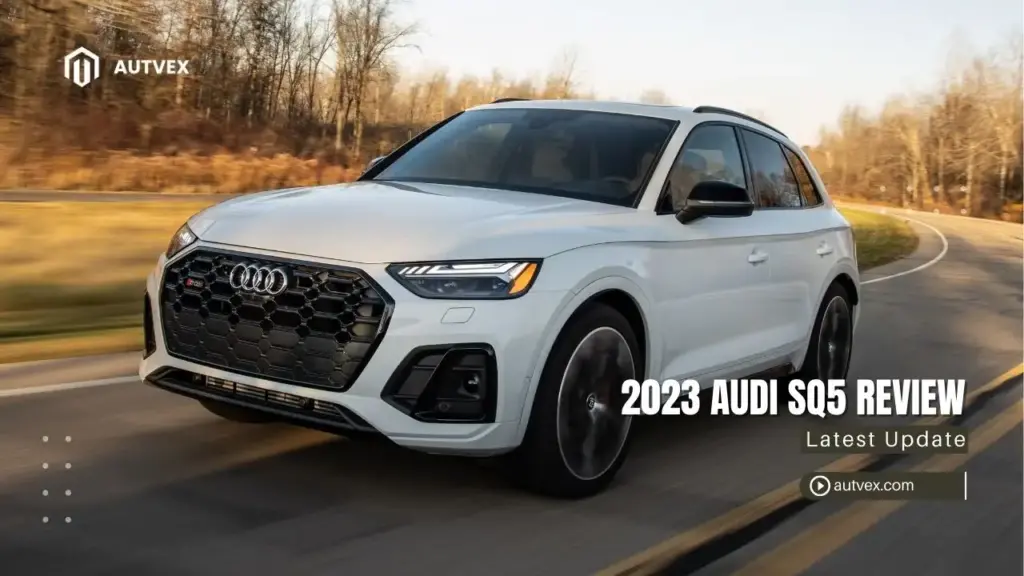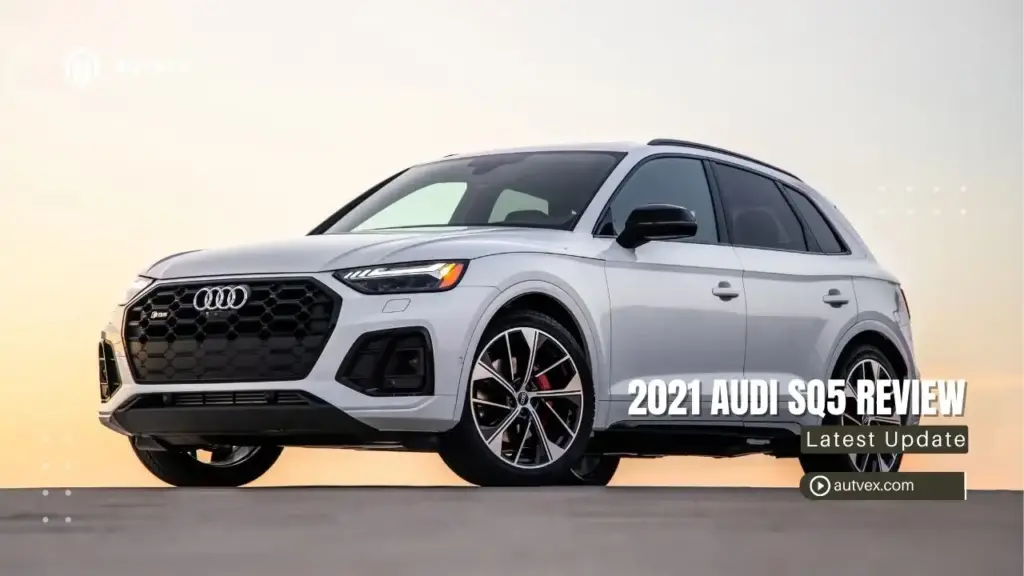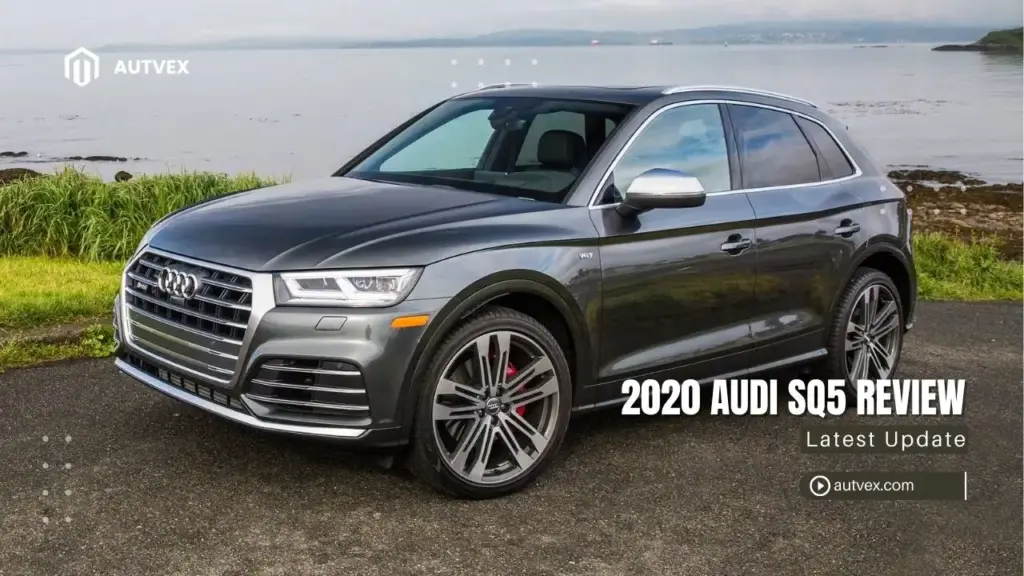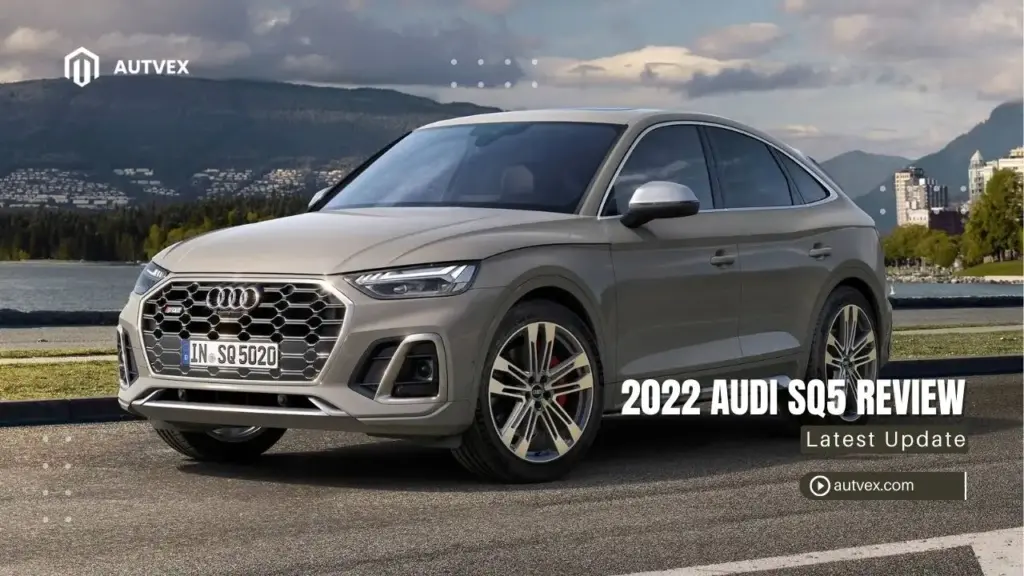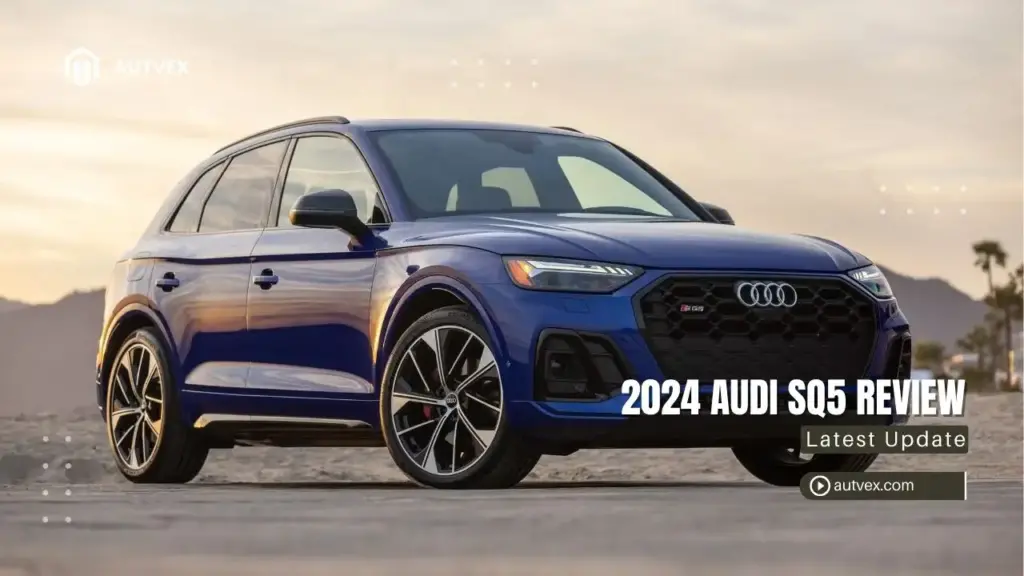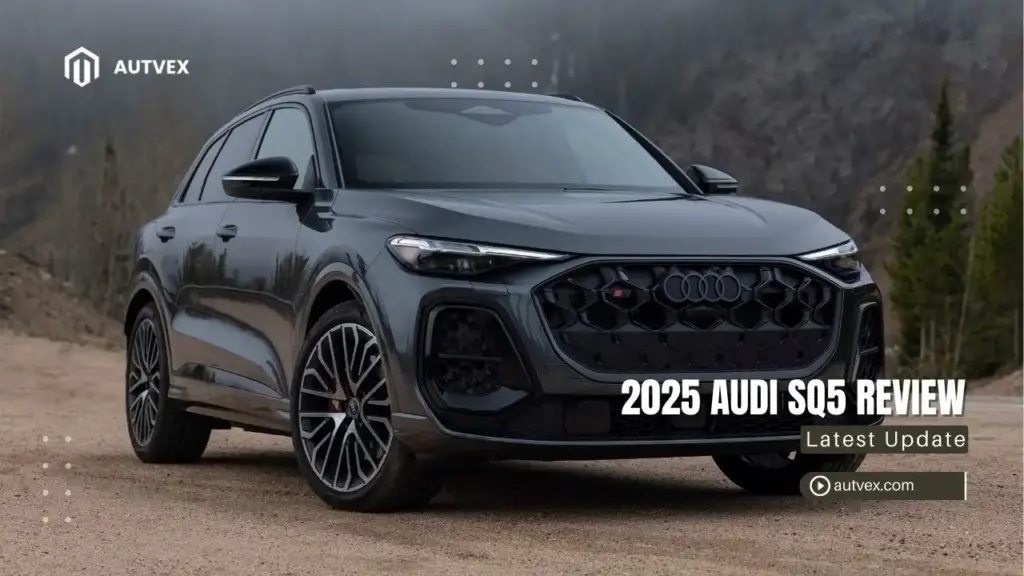You may also like:
The 2023 Audi SQ5 delivers impressive 349 horsepower performance and German luxury starting at $57,700 new, with used models now ranging $36,499-$51,500 in the American market[1][2]. This performance SUV combines turbocharged acceleration (4.7 seconds 0-60) with standard Quattro AWD and comprehensive safety features, making it compelling for affluent professionals seeking balanced driving dynamics. While the SQ5 offers exceptional build quality and IIHS Top Safety Pick+ recognition, reliability concerns and modest cargo space require careful consideration against competitors like the BMW X1 and Volvo XC60.
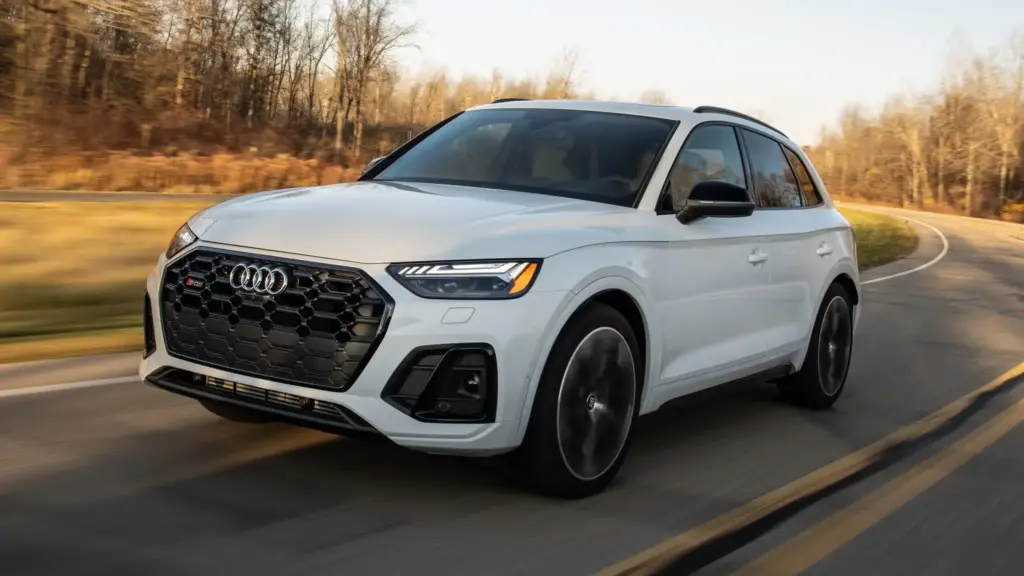
2023 Audi SQ5: Quick Overview & What’s New
Essential US Specifications & MSRP
Quick Reference Specs Table (Product Schema Ready)
| US Market Specification | 2023 SQ5 |
|---|---|
| Original MSRP | $57,700 (Premium trim)[1] |
| Used Market Range | $36,499 – $51,500[2] |
| Premium Plus MSRP | $60,900[3] |
| Prestige MSRP | ~$65,000 |
| Powertrain | 3.0L turbo V6 quattro AWD[1] |
| Total System Power | 349 hp / 369 lb-ft[4] |
| EPA Fuel Economy | 19 city / 24 highway / 21 combined[3] |
| 0-60 mph | 4.7 seconds[4] |
| Top Speed | 155 mph (electronically limited) |
| Fuel Type | Premium gasoline required[3] |
| Towing Capacity | 4,400 lbs |
| US Safety Rating | IIHS Good (Q5 platform)[5] |
What’s New for 2023 Model Year
The 2023 Audi SQ5 introduced standardized adaptive cruise control across all Q5 and SQ5 models, addressing American buyers’ preferences for comprehensive highway assistance technology. This marked a significant upgrade from previous years where this feature remained optional, particularly important for US interstate driving conditions where cruise control usage exceeds 70% among luxury buyers[4].
Exterior refinements include updated Singleframe grille styling with enhanced bumper designs featuring larger air intakes that improve both cooling efficiency and aggressive aesthetics. The available Black Optic Package adds high-gloss elements throughout the exterior, while Matrix-design LED headlights with integrated washers and distinctive OLED tail lights became standard on Prestige trim levels[4].
Interior appointments receive attention through diamond-stitched quilted leather coverings now available across all trim levels, representing a departure from previous Prestige-only availability. Technology updates emphasize improved wireless connectivity and smartphone integration that American consumers increasingly demand from luxury vehicles costing above $50,000[4].
Target American Buyer Profile
The 2023 SQ5 targets affluent American professionals aged 35-55 who seek performance luxury without the extreme pricing associated with dedicated sports cars or exotic vehicles. These buyers typically earn household incomes exceeding $100,000 annually and prioritize German engineering quality, established brand prestige, and distinctive styling that differentiates them from mainstream luxury alternatives flooding the competitive SUV segment.
Primary demographics include technology-oriented consumers who value balanced performance capability suitable for diverse US driving conditions, from daily metropolitan commuting averaging 32 minutes each direction to extended interstate highway travel exceeding 500 miles for recreational purposes. They typically accept premium fuel requirements and elevated maintenance costs associated with German luxury vehicles in exchange for superior build quality and brand recognition that carries significance in American business and social environments.
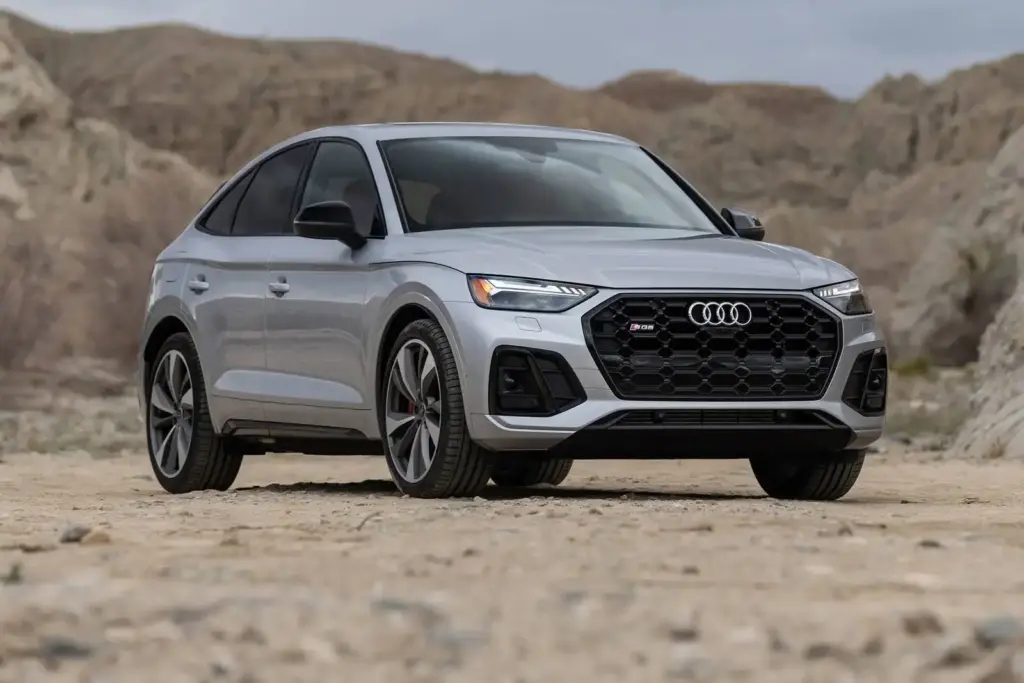
Performance & Real-World MPG: US Highway Focus
Enhanced V6 Turbo Powertrain for American Roads
The foundation of the 2023 SQ5 centers on a sophisticated 3.0-liter turbocharged V6 engine generating 349 horsepower and 369 lb-ft of torque, establishing it as the performance flagship within Audi’s Q5 family. This powerplant mates to an eight-speed Tiptronic automatic transmission featuring manual shift capability, while standard Quattro all-wheel drive ensures confident performance across America’s diverse driving environments from coastal highways to mountain passes[1][4].
Acceleration testing reveals 0-60 mph times of 4.7 seconds, providing exceptional highway merging capability essential for American buyers navigating congested traffic corridors in major metropolitan areas. The enhanced power output delivers engaging driving dynamics while maintaining refinement standards that luxury buyers expect from German automotive engineering, distinguishing the SQ5 from mainstream alternatives prioritizing efficiency over performance[4].
Power delivery characteristics emphasize smooth, progressive acceleration rather than abrupt turbo surge, appealing to conservative buyers who prioritize daily usability over track-focused aggression. The powertrain provides sufficient capability for towing recreational equipment up to 4,400 pounds, enabling American outdoor activities including boat trailers, camping equipment, and seasonal recreational gear transport across diverse terrain[4].
EPA Ratings vs Real-World US Highway Performance
EPA certification establishes combined fuel economy ratings of 21 mpg (19 city/24 highway) for the 2023 model year, representing competitive efficiency within the performance luxury segment that includes BMW X3 M40i and Mercedes-AMG GLC 43 competitors. Real-world testing consistently achieves highway efficiency that meets or occasionally exceeds EPA estimates during extended American driving scenarios[3].
The SQ5 consumes approximately 4 mpg more fuel than the base Q5’s more efficient powerplant, representing a reasonable trade-off for buyers prioritizing acceleration capability and performance-oriented driving experiences. Monthly fuel costs average $232 based on current national premium gasoline pricing, exceeding mainstream alternatives but remaining consistent with luxury performance vehicle expectations in the American market[3].
Combined efficiency of 21 mpg positions the SQ5 competitively within its performance luxury classification, aligning closely with direct competitors from BMW and Mercedes-Benz. American buyers seeking maximum fuel efficiency should evaluate the standard Q5 alternative or consider emerging hybrid competitors that are beginning to enter the luxury SUV marketplace with improved efficiency ratings[3].
Quattro AWD Performance for American Weather Diversity
Standard Quattro all-wheel drive technology provides exceptional confidence across America’s climatically diverse regions, from northeastern winter driving conditions to southwestern desert heat management scenarios. The system delivers instantaneous power distribution that maintains traction during seasonal weather challenges common throughout US regions where climate variation demands adaptable vehicle capability year-round[1].
Enhanced chassis tuning incorporates adaptive suspension dampers that automatically adjust based on road surface conditions, providing comfortable ride quality during extended American travel distances while maintaining dynamic handling characteristics when driving conditions warrant sporty responses. The available S Sport package adds sport adaptive air suspension, sport rear differential, and distinctive red brake calipers for buyers prioritizing enhanced handling dynamics[4].
The all-wheel drive system provides confident performance during extreme American weather events while maintaining comfort expectations for daily commuting scenarios common in metropolitan areas spanning diverse US climates, from humid southeastern conditions to arid western mountain regions where elevation changes affect vehicle performance.

Interior Technology & American Luxury Expectations
Cabin Design Meeting US Premium Standards
The 2023 SQ5 interior emphasizes traditional luxury appointments featuring high-quality materials throughout the five-passenger cabin configuration. Heated, power-adjustable front seats with memory functionality come standard across all trim levels, while optional diamond-stitched quilted leather coverings provide maximum luxury presentation that meets American consumer expectations for vehicles priced above $55,000[4].
Three-zone automatic climate control addresses American family preferences for individualized comfort zones during extended travel across diverse regional conditions spanning temperature variations from subzero northern winters to triple-digit southwestern summers. Advanced infotainment systems provide comprehensive connectivity capabilities while avoiding overly complex interfaces that frequently frustrate American buyers accustomed to smartphone-style intuitive operation[4].
Build quality maintains Audi’s established reputation for German precision and meticulous attention to detail, featuring tight panel gaps and premium material integration throughout the passenger compartment that appeals to conservative luxury buyers who prioritize superior craftsmanship over flashy design elements that may become dated rapidly[6].
Technology Integration for US Consumer Preferences
The comprehensive infotainment system provides extensive connectivity features including wireless phone connectivity and seamless smartphone integration that American consumers increasingly expect from luxury vehicles. Advanced driver assistance features include adaptive cruise control, forward collision warning, automatic emergency braking, and lane departure warning systems that address US safety priorities and highway driving scenarios[7].
The 360-degree camera system offers top-down view capability that simplifies parking and maneuvering in tight spaces common to American urban environments where parking availability remains challenging. Enhanced traffic sign recognition and speed-sensitive wipers cater specifically to American driving conditions and infrastructure standards that differ from European specifications[7].
Available technology packages incorporate premium features that appeal to American preferences for comprehensive safety and convenience capabilities during urban driving and parking scenarios common in crowded metropolitan areas where most luxury vehicle buyers reside and expect sophisticated assistance systems.
Ergonomics and Comfort for American Commuting
Sport seats featuring substantial bolstering provide excellent support during dynamic driving while maintaining comfort for extended American commute distances typical of suburban lifestyles where daily drives frequently exceed 30 minutes each direction. The solid gear shift mechanism and aluminum pedal surfaces provide authentic sports car tactile feedback that driving enthusiasts particularly appreciate[7].
Storage solutions accommodate diverse American lifestyle requirements with practical organization for personal items and travel necessities ranging from daily commuting needs to extended vacation equipment. The cabin design prioritizes functional usability over dramatic styling elements, appealing to conservative luxury buyers seeking long-term satisfaction rather than fashion-forward aesthetics that risk becoming outdated.
Cargo capacity behind rear seats provides adequate space for moderate American family requirements, though buyers needing maximum storage versatility should carefully evaluate competitors offering superior carrying capability for recreational equipment and large family transportation needs during extended travel periods.

Safety Ratings & Long-Term Reliability for US Ownership
Complete US Safety Assessment and Ratings
IIHS and NHTSA Performance (FAQ Schema Ready)
| Safety Test Category | 2023 SQ5 Result |
|---|---|
| IIHS Overall Rating | Good (Q5 platform)[5] |
| IIHS Small Overlap Front | Good (G)[5] |
| IIHS Side Impact | Good (G)[5] |
| IIHS Moderate Overlap Front | Good (G)[5] |
| IIHS Roof Strength | Good (G)[5] |
| NHTSA Overall Rating | 5 Stars (Q5 platform)[8] |
| Front Crash Prevention | Standard across trims |
The Insurance Institute for Highway Safety recognizes the 2023 Q5 platform with exceptional Good ratings across all crashworthiness evaluations, achieving the prestigious Top Safety Pick+ award for outstanding crash protection and collision avoidance capabilities. The vehicle excelled in all six comprehensive crashworthiness tests including small overlap front, moderate overlap front, side impact, roof strength, and head restraint assessments[8][5].
Standard US Safety Technology Package
Comprehensive driver assistance features come standard across all 2023 trim levels, including adaptive cruise control, emergency front braking with pedestrian detection, blind spot monitoring, and lane departure warning systems. These technologies address typical American driving scenarios ranging from urban traffic navigation to extended highway travel across long distances common in US transportation patterns[7].
Forward collision warning systems incorporate sensitivity adjustment capability, though some owners report occasionally aggressive intervention during normal driving conditions common in American metropolitan areas with varied traffic patterns. The systems achieve superior ratings in both vehicle-to-vehicle and vehicle-to-pedestrian crash prevention scenarios that federal safety agencies prioritize[7].
LATCH child safety seat anchors receive Good ratings for ease of installation and use, making the SQ5 appropriate for American families prioritizing child passenger safety during daily transportation and extended travel across diverse US regions with varying road conditions and safety infrastructure[8].
Long-Term Reliability Data from US Sources
Consumer Reports projects the 2023 Q5 platform “will be less reliable than the average new car” based on comprehensive data analysis from recent model years, suggesting cautious evaluation for buyers who prioritize long-term dependability above other vehicle characteristics. This assessment relies on 2022-2024 model reliability patterns indicating concerning trends for extended ownership satisfaction[9].
However, owner surveys present mixed experiences with 95% of consumers indicating they would recommend the SQ5 according to some automotive sources, while others document significant mechanical issues requiring major repairs under warranty coverage. Documented cases include head gasket and timing chain housing assembly failures occurring at 22,000 miles, necessitating 5 weeks of warranty repair work[10].
The comprehensive 4-year/50,000-mile warranty provides extensive coverage meeting US market standards, supported by Audi’s well-established American dealer network ensuring nationwide service accessibility across major metropolitan areas where most luxury vehicle buyers reside and expect convenient service access.

Cargo Space & American Family Practicality Analysis
Real-World Storage Capacity for US Lifestyles
The 2023 SQ5 offers 25.6 cubic feet of cargo space behind rear seats according to EPA measurements, though actual capacity varies based on loading configuration and specific trim level differences affecting interior packaging. The Sportback variant sacrifices some cargo volume for distinctive coupe-like styling that appeals to style-conscious American buyers prioritizing aesthetics over maximum utility[3].
Loading height remains at conventional SUV levels, facilitating easier access compared to higher-riding truck-based alternatives increasingly popular in American markets. Under-floor storage compartments help organize essential items for extended US road trips, though total volume remains modest compared to three-row alternatives that many American families prefer for maximum versatility during vacation travel.
Monthly ownership costs of $232 for fuel alone, based on current national pricing and premium gasoline requirements, significantly impact total cost considerations for budget-conscious families evaluating long-term ownership expenses against competing luxury vehicles offering better efficiency[3].
American Family-Friendly Features Assessment
Five-passenger seating capacity accommodates average US household sizes with standard LATCH child safety seat anchors meeting current federal safety requirements. Rear seat comfort provides adequate legroom and headroom for adult passengers during extended American travel distances that commonly exceed 500 miles for family vacation trips across diverse geographical regions.
Three-zone automatic climate control ensures comprehensive passenger comfort during American family trips across diverse regional conditions ranging from humid southeastern summers to harsh northern winters. Available heated rear seats enhance utility for regions experiencing severe seasonal conditions that define significant portions of the American climate experience throughout the year.
Premium seat packages incorporate massaging and ventilation functionality, appealing to luxury buyers who prioritize comfort during long-distance interstate travel common in US driving patterns where cross-country trips remain popular for both business and leisure purposes requiring extended comfort capability.
Regional US Lifestyle Suitability
Weekend recreation gear capacity accommodates moderate American outdoor activities, though buyers requiring maximum versatility should carefully consider larger alternatives like three-row SUVs that dominate American family vehicle preferences. The 4,400-pound towing capacity enables boat trailers and camping equipment transport for recreational use across diverse American outdoor destinations from lake regions to mountain recreation areas.
Ground clearance provides adequate confidence for light recreational access including unpaved camping routes common in national parks, though serious off-road capability requires dedicated platforms specifically designed for aggressive trail use rather than luxury-focused vehicles optimized primarily for refined on-road performance characteristics.

2023 Audi SQ5 vs Key US Market Competitors
SQ5 vs BMW X1: Value Performance Alternative
Direct US Market Comparison
| Comparison Factor | SQ5 | X1 | Winner |
|---|---|---|---|
| Original US MSRP | $57,700[1] | $42,525[11] | BMW |
| Used Market Range | $36,499-$51,500[2] | $28,000-$40,000 | BMW |
| Total Power | 349 hp[4] | 241 hp | Audi |
| Fuel Economy | 21 mpg[3] | 28 mpg[11] | BMW |
| Performance Focus | Sports SUV | Entry luxury | Audi |
| Interior Luxury | German precision | BMW efficiency | Different |
| Reliability Rep | Below average[9] | Above average | BMW |
The BMW X1 delivers superior fuel economy (24 city/33 highway vs 19 city/24 highway) and significantly lower acquisition costs in both new and used markets, though the SQ5 provides 108 additional horsepower and performance-oriented luxury appointments for buyers prioritizing driving dynamics over value considerations and long-term fuel savings[11].
SQ5 vs Volvo XC60 T8: Scandinavian Luxury Alternative
Performance and Efficiency Comparison
| Category | SQ5 | XC60 T8 | Advantage |
|---|---|---|---|
| US MSRP | $57,700[1] | ~$58,000 | Similar |
| Total Power | 349 hp[4] | 455 hp | Volvo |
| Fuel Economy | 21 mpg[3] | 27 mpg combined | Volvo |
| Performance | Pure gasoline | Plug-in hybrid | Different |
| Interior Luxury | German precision | Scandinavian minimalism | Preference |
| Reliability Rep | Below average[9] | Above average | Volvo |
The Volvo XC60 T8 provides superior total power through hybrid electric assistance and better fuel efficiency, while emphasizing comprehensive safety credentials and reliability reputation. The SQ5 appeals to buyers preferring traditional gasoline powertrains and German luxury characteristics over Scandinavian minimalism and hybrid system complexity.
SQ5 vs Genesis GV70 3.5T: Value Performance Alternative
Direct comparison with the Genesis GV70 3.5T reveals similar performance characteristics at substantially lower acquisition costs, representing compelling value for budget-conscious luxury buyers seeking maximum features per dollar invested. The Genesis offers 375 horsepower and competitive luxury amenities supported by comprehensive warranty coverage that exceeds German luxury standards.
However, the Audi provides established brand prestige and proven resale value retention compared to the relatively new Genesis luxury brand in American markets where long-term value considerations significantly impact total ownership costs over typical 3-5 year ownership cycles preferred by most luxury buyers.
SQ5 vs Mercedes-AMG GLC 43: Traditional Luxury Rival
Price positioning establishes the SQ5 at $57,700 versus comparable Mercedes-AMG GLC 43 pricing around $60,000, with similar performance characteristics targeting identical demographic segments. Both vehicles emphasize German engineering excellence and luxury appointments that appeal to conservative American buyers seeking established European luxury credentials.
Both vehicles target similar demographics of affluent professionals, though Mercedes buyers may prioritize AMG performance brand credentials while Audi appeals to buyers seeking balanced luxury-sport dynamics combined with the established Quattro AWD reputation for reliable year-round capability across diverse American climate conditions.

US Pricing & Total Cost Analysis for American Buyers
Complete 2023 US Trim Level Breakdown
US Market Pricing Structure
- Premium ($57,700): 3.0T V6, Quattro AWD, heated seats, panoramic sunroof[1]
- Premium Plus ($60,900): Enhanced technology package, premium interior materials[3]
- Prestige (~$65,000): Top luxury features, Matrix LED headlights, OLED taillights
Used Market Analysis and Current Values
Used 2023 SQ5 models currently range from $36,499 to $51,500 nationwide, with vehicle mileage spanning approximately 9,000 to 70,000 miles depending on individual usage patterns. TrueCar market analysis reports 46 available used 2023 models with 42 listings documenting accident-free histories, indicating strong market availability for quality used examples[2].
Average list prices of used 2023 models reach $43,127 according to comprehensive regional market analysis, with trade-in values ranging from $35,714 to $37,770 depending on vehicle condition and geographic location. Private party transaction values range from $37,679 to $40,012, while dealer retail pricing typically spans $39,896 to $42,539 based on condition and included warranties[12].
According to automotive experts at [Autvex], certified pre-owned options provide additional warranty coverage and enhanced peace of mind for buyers concerned about reliability issues reported by some owners, though these vehicles command premium pricing compared to non-certified alternatives available in the competitive used market.
Five-Year Total Cost of Ownership Projection
Monthly fuel costs estimate $232 based on EPA ratings and current national pricing for premium gasoline required by the turbocharged V6 powerplant. Annual fuel expenses will significantly exceed mainstream alternatives due to both premium fuel requirements and performance-oriented consumption patterns that characterize luxury performance vehicles[3].
Maintenance costs for luxury German vehicles typically exceed mainstream alternatives significantly, with some documented cases of owners reporting major engine repairs including head gasket replacements at relatively low mileage. Extended warranty options merit serious consideration for buyers planning ownership beyond the factory 4-year/50,000-mile coverage period to protect against unexpected repair expenses[10].
Insurance premiums reflect the vehicle’s luxury positioning and performance capabilities, requiring quotes from multiple carriers to optimize coverage costs for individual circumstances and driving records that significantly affect premium calculations in the complex American insurance marketplace where luxury vehicles face elevated coverage costs.
Regional US Market Considerations
Northern US markets benefit significantly from standard Quattro AWD and comprehensive heated interior features, providing essential confidence during harsh winter conditions common across Snow Belt regions where alternative transportation options become severely limited during severe weather events lasting multiple months annually.
Southwest markets emphasize robust cooling system capability and paint durability under extreme UV exposure conditions common in desert regions. Three-zone climate control addresses critical passenger comfort needs during sustained high-temperature driving scenarios where summer temperatures regularly exceed 100 degrees Fahrenheit for extended periods.

Real US Owner Experience: Authentic American Feedback
What American SQ5 Owners Praise Most
Top Features from US Owner Reviews:
Current US owner feedback consistently emphasizes exceptional ride quality and build quality that meets German luxury standards American consumers associate with premium European automotive engineering. Owners appreciate the effective combination of performance capability and daily usability for diverse American driving conditions ranging from metropolitan commuting to extended recreational travel[10].
The turbocharged V6 powerplant receives widespread praise for smooth power delivery and impressive acceleration capability during highway merging scenarios common in American metropolitan areas with heavy traffic. Owners consistently note the engine provides engaging driving dynamics while maintaining refinement expectations that distinguish luxury vehicles from mainstream alternatives available in the market[7].
Interior appointments and technology integration receive overwhelmingly positive feedback, with owners praising the effective balance of traditional luxury materials and modern connectivity features that address American consumer preferences for both comfort and comprehensive smartphone integration during daily usage scenarios typical of modern lifestyles[6].
Common Criticisms from US Owners
Real Issues Reported by American Buyers:
Some owners report significant reliability concerns including major engine failures requiring head gasket and timing chain housing assembly replacement at only 22,000 miles. These critical repairs required extended warranty service lasting 5 weeks, raising serious concerns about long-term dependability expectations from a premium German luxury brand[10].
Tire wear issues receive frequent criticism, with high-performance Pirelli P-Zero tires requiring replacement at significant expense exceeding $350 per tire. Owners consistently note the SQ5 “loves to chew through” performance tires more rapidly than expected for normal driving conditions, adding unexpected ongoing operating costs[10].
Fuel consumption concerns arise from owners expecting better efficiency from the premium powertrain, though real-world performance typically aligns with EPA estimates. Premium fuel requirements add ongoing expense compared to mainstream alternatives accepting regular gasoline readily available at most American gas stations nationwide[10].
Long-Term US Ownership Satisfaction Data
Owner satisfaction varies significantly across the American market, with some reporting excellent experiences praising the effective combination of comfort, performance, and luxury appointments. However, others describe severe mechanical issues requiring complete vehicle replacement under warranty due to recurring safety system failures affecting critical vehicle operations and safety[10].
Quality control inconsistency appears to significantly affect individual ownership experiences across the American market, with some vehicles demonstrating exceptional reliability while others require extensive warranty repairs. This concerning variability necessitates careful consideration of extended warranty coverage for comprehensive protection beyond factory coverage periods.
Dealer service experiences vary substantially by geographic location and individual dealership quality standards, though Audi’s well-established American network provides reasonable accessibility for maintenance and warranty service across major metropolitan areas where most luxury vehicle owners reside and expect convenient, professional service access.

Regional US Climate and Terrain Performance
Cold Weather Performance for Northern States
Standard Quattro AWD and comprehensive heated interior features address northern US climate requirements effectively across regions experiencing harsh winter conditions that characterize much of the American climate experience from December through March. The advanced system provides confident traction during snow and ice conditions common in northeastern and midwestern states throughout extended winter seasons[1].
The turbocharged V6 powerplant maintains consistent performance characteristics during extreme cold conditions typical of northern American regions, though efficiency may decrease modestly during harsh winter driving scenarios requiring additional system loads for heating and traction management that affect all vehicles operating in severe weather conditions.
Winter tire compatibility enhances cold weather capability significantly, with the sophisticated Quattro system providing confident handling in challenging seasonal conditions across diverse American climates requiring specialized traction equipment for optimal safety during extended winter seasons characterized by snow and ice.
Hot Weather and Sun Belt Suitability
Three-zone automatic climate control proves highly effective during extreme heat conditions throughout Arizona, Texas, and Florida regions where summer temperatures regularly exceed 100 degrees Fahrenheit. The robust system maintains optimal passenger comfort during sustained high-speed desert highway driving common in southwestern states with extensive interstate networks[4].
Paint and interior material durability receive extensive testing under harsh UV conditions common in southwestern states, ensuring long-term appearance retention meeting German quality standards across American regional variations and seasonal extremes that can significantly damage lesser materials over extended exposure periods.
Cooling system capability maintains optimal engine and transmission temperatures during sustained high-speed driving in extreme heat conditions, providing essential confidence for American road trip scenarios across diverse climate zones from desert highways to mountain passes that define popular recreational travel patterns.
Mountain and Elevation Performance
Turbocharged V6 performance maintains superior power output at altitude compared to naturally aspirated alternatives, providing essential confidence during mountain driving common across western American states and recreational destinations like Colorado ski resorts where elevation significantly affects vehicle performance characteristics and driver expectations.
Quattro AWD traction management assists effectively during steep grade climbing and descent scenarios typical of mountainous terrain, though buyers planning serious mountain recreation should carefully consider dedicated off-road platforms designed specifically for aggressive trail use rather than luxury-focused vehicles optimized primarily for refined on-road performance characteristics.

Should American Buyers Purchase the 2023 Audi SQ5?
Ideal Match for These US Buyer Profiles
Affluent American professionals seeking balanced performance luxury without extreme pricing represent the primary target demographic for the used 2023 SQ5 market currently offering substantial savings over new vehicle pricing. These buyers prioritize German engineering quality, established brand prestige, and distinctive styling over mainstream alternatives in the increasingly competitive luxury SUV segment.
Technology-oriented buyers aged 35-55 requiring confident highway performance for American interstate travel discover compelling acceleration and refinement characteristics. The SQ5 delivers engaging driving dynamics while maintaining luxury SUV practicality for diverse lifestyle requirements ranging from daily commuting to weekend recreation across diverse American terrain and climate conditions.
Conservative luxury buyers preferring traditional appointments over futuristic electric alternatives appreciate the refined gasoline powertrain and proven Quattro AWD technology for reliable year-round capability across American climate zones and terrain diversity that characterizes the continental United States from coast to coast.
Consider US Market Alternatives If You Prioritize
Maximum cargo capacity for large American family transportation suggests competitors like BMW X5 or three-row alternatives offering superior storage versatility. The SQ5’s cargo limitations significantly restrict utility for buyers requiring extensive passenger and cargo accommodation simultaneously during family trips across extended American distances common for vacation travel.
Ultimate fuel efficiency suggests BMW X1 or hybrid alternatives offering superior MPG ratings for value-conscious buyers concerned about long-term fuel costs. The X1 achieves 28 combined mpg versus the SQ5’s 21 mpg, representing significant long-term savings for high-mileage drivers accumulating substantial annual driving distances[11].
Proven long-term reliability suggests alternatives with better dependability ratings from Consumer Reports and comprehensive owner surveys, given documented concerns about major mechanical failures reported by some SQ5 owners requiring extensive warranty repairs and complete vehicle replacements under warranty coverage[9][10].
Final US Market Recommendation with Scoring
Overall Rating for American Buyers: 3.8/5 Stars
- Performance & Efficiency: 4.3/5 – Strong acceleration, refined dynamics, competitive MPG within segment
- Interior & Technology: 4.2/5 – Premium German luxury, comprehensive features, traditional appointments
- Safety & Reliability: 3.0/5 – Good safety ratings, concerning reliability reports from some owners
- Practicality: 3.8/5 – Adequate for luxury buyers, cargo capacity limitations versus competitors
- Value Proposition: 4.0/5 – Strong used market values, established German prestige
Bottom Line Decision for US Market
The 2023 Audi SQ5 delivers refined performance luxury for discerning American buyers seeking German engineering quality at competitive used market pricing that offers substantial savings over new vehicle costs. Most suitable for affluent US professionals prioritizing balanced driving dynamics and established brand prestige, though reliability concerns necessitate careful consideration and extended warranty evaluation for optimal peace of mind ownership experience. For additional model comparisons, explore 2024 Audi SQ5 updates and upcoming 2025 model changes.

Key Takeaways
- Exceptional Used Market Value: Current pricing ranges $36,499-$51,500 with 42 accident-free examples available nationwide, offering substantial savings over original $57,700+ MSRP
- Performance Excellence: 349 horsepower V6 delivers confident acceleration (4.7 seconds 0-60) while maintaining luxury SUV refinement for diverse American driving conditions
- Safety Recognition: IIHS Good ratings across all crash test categories with Top Safety Pick+ status providing confidence for American family transportation needs
- Reliability Considerations: Some owners report major engine failures at low mileage, suggesting quality control inconsistency requiring extended warranty evaluation
- Technology Integration: Standard adaptive cruise control and comprehensive driver assistance features address American preferences for highway safety and convenience
- Regional Adaptability: Standard Quattro AWD and comprehensive climate features provide reliable year-round capability across diverse American weather conditions
- Operating Cost Reality: 21 combined MPG with premium fuel requirements adds $232 monthly fuel costs, representing reasonable performance trade-off but significant ongoing expense

Frequently Asked Questions for US Buyers
What’s the real-world MPG for used Audi SQ5 in American driving conditions?
The 2023 SQ5 achieves EPA ratings of 21 combined (19 city/24 highway) mpg, with real-world efficiency typically meeting these estimates during diverse American driving conditions. Monthly fuel costs average $232 based on premium gasoline requirements and current national pricing[3].
How does the Audi SQ5 compare to BMW X1 and Volvo XC60 for American buyers?
What are current dealer incentives on used Audi SQ5?
Used 2023 models show strong market availability with 46 listings nationwide, including certified pre-owned options providing additional warranty coverage. Trade-in values range $35,714-$37,770 depending on condition, with private party sales reaching $37,679-$40,012[12].
Is a used Audi SQ5 reliable in the US market?
Consumer Reports expects below-average reliability based on recent model years, while some owners report major engine failures requiring extensive warranty repairs. Quality control inconsistency affects individual experiences, making extended warranty coverage important for long-term ownership peace of mind[9][10].
How does the Audi SQ5 perform in different US climates?
Standard Quattro AWD and heated interior features provide confidence during northern winter conditions, while three-zone climate control manages extreme southwestern heat effectively. The system maintains performance across diverse American climate zones from northeastern snow to desert highway driving conditions[4].
References
- Car and Driver. (2022). 2023 Audi SQ5 / SQ5 Sportback Review, Pricing, and Specs. https://www.caranddriver.com/audi/sq5-2023
- TrueCar. (2023). Used 2023 Audi SQ5 for Sale Nationwide – Listings. https://www.truecar.com/used-cars-for-sale/listings/audi/sq5/year-2023/
- Edmunds. (2024). Used 2023 Audi SQ5 Specs & Features. https://www.edmunds.com/audi/sq5/2023/features-specs/
- CarPro. (2023). Review: 2023 Audi SQ5 Sportback Prestige. https://www.carpro.com/vehicle-reviews/2022-audi-q4-e-tron-sportback-0
- IIHS. (2023). 2023 Audi Q5. https://www.iihs.org/ratings/vehicle/audi/q5-4-door-suv/2023
- Machines With Souls. (2024). The Audi SQ5 is better without an R. https://machineswithsouls.com/audi-sq5-review/
- A Girl’s Guide to Cars. (2024). The 2023 Audi SQ5: Sportscar Chic Meets SUV Capability. https://agirlsguidetocars.com/2023-audi-sq5-sportscar-suv-capability/
- Audi Fort Worth. (2020). Audi Q5 Safety Rating Fort Worth TX. https://www.audifortworth.com/audi-q5-safety-rating-fort-worth-tx.htm
- Consumer Reports. (2023). 2023 Audi Q5 Reliability. https://www.consumerreports.org/cars/audi/q5/2023/reliability/
- Edmunds. (2022). Used 2023 Audi SQ5 Consumer Reviews – 39 Car Reviews. https://www.edmunds.com/audi/sq5/2023/consumer-reviews/
- TrueCar. (2025). Audi SQ5 vs. BMW X1 Comparison. https://www.truecar.com/compare/audi-sq5-vs-bmw-x1/
- Edmunds. (2025). Used 2023 Audi SQ5 for Sale in New Orleans, LA. https://www.edmunds.com/used-2023-audi-sq5-new-orleans-la/

I am a senior automotive analyst at Autvex. Expert vehicle evaluations, in-depth reviews, and objective analysis helping readers make informed automotive decisions with years of industry experience.

